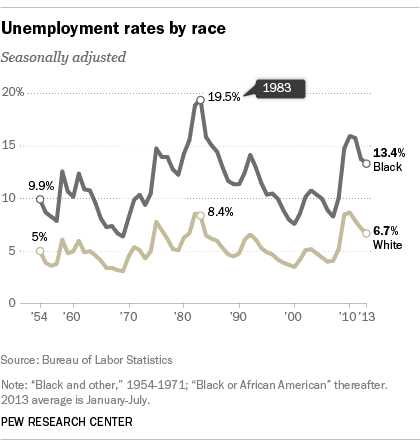
Much has changed for African-Americans since the 1963 March on Washington (which, recall, was a march for “Jobs and Freedom”), but one thing hasn’t: The unemployment rate among blacks is about double that among whites, as it has been for most of the past six decades.
In 1954, the earliest year for which the Bureau of Labor Statistics has consistent unemployment data by race, the white rate averaged 5% and the black rate averaged 9.9%. Last month, the jobless rate among whites was 6.6%; among blacks, 12.6%. Over that time, the unemployment rate for blacks has averaged about 2.2 times that for whites.
The widest gaps, when black unemployment was as much as 2.77 times that of white unemployment, came in the late 1980s, as the manufacturing sectors that employed disproportionate shares of African-Americans shriveled. The smallest gaps, ironically, came in the summer of 2009 during the Great Recession; white unemployment rose so high, so fast, that the black jobless rate was “only” 1.67 times higher.
The black-white unemployment gap appears to have emerged in the 1940s, according to a 1999 analysis of Census data. Although labor economists, sociologists and other researchers have offered many explanations for the persistent 2-to-1 gap — from the differing industrial distribution of black and white workers to a “skills gap” between them — there’s no consensus on causes. One 2011 working paper, after reviewing existing research on wage and unemployment differentials among blacks and whites, concluded that “none of the existing models of race discrimination in the labor market explains the major empirical regularities.”
[E]
